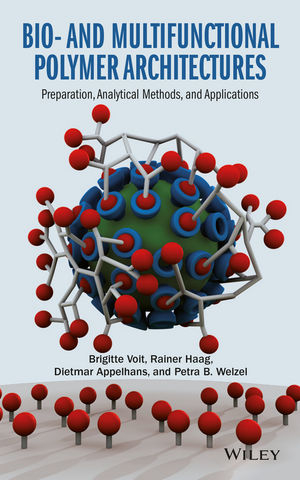
Bio- and Multifunctional Polymer Architectures
John Wiley & Sons Inc (Verlag)
978-1-118-15891-3 (ISBN)
Brigitte Voit is head of the Institute of Macromolecular Chemistry at the Leibniz Institute of Polymer Research (IPF)Dresden, as well as professor of Organic Chemistry of Polymers at the University of Technology Dresden (TUD). In addition, she is heads the IPF Dresden as Managing Director and Chief Scientific Officer (Scientific Director). Rainer Haag is full professor in organic and macromolecular chemistry at the Freie Universität, Berlin. Dietmar Appelhans is a post-doctorial member in the working group of Professor Brigitte Voit at the Leibniz Institute of Polymer Research (IPF) Dresden and focuses on dendritic polymers.
Preface xi
Acknowledgments xiii
1 Introduction 1
1.1 What makes Polymers so Interesting? 1
1.2 Macromolecular Engineering and Nanostructure Formation 4
1.3 Specific Needs in Bionanotechnology and Biomedicine 5
Reference 6
2 Terminology 7
2.1 Polymer Architectures 7
2.2 Multifunctionality 11
2.3 Bioconjugates 12
2.4 Biocompatibility 12
2.5 Biodegradation 14
2.6 Bioactivity 14
2.7 Multivalency 15
2.8 Bionanotechnology 17
References 18
3 Preparation Methods and Tools 19
3.1 General Aspects of Polymer Synthesis 19
3.1.1 Chain Growth Polymerizations 20
3.1.2 Step Growth Polymerizations 23
3.1.3 Modification of Polymers 25
3.2 Controlled Polymer Synthesis 25
3.2.1 Anionic Polymerization 26
3.2.2 Cationic Polymerization 30
3.2.3 Controlled Radical Polymerization 34
3.2.4 Metal‐Catalyzed Polymerization 37
3.2.5 Chain Growth Condensation Polymerization 41
3.3 Effective Polymer Analogous Reactions 43
3.4 Pegylation 47
3.5 Bioconjugation 51
3.5.1 Polynucleotide Conjugates 53
3.5.2 Protein Conjugates 55
3.5.3 Polysaccharide Conjugates 57
3.6 Enzymatic Polymer Synthesis 59
3.7 Solid Phase Synthesis and Biotechnological Approaches 63
3.7.1 Solid Phase Synthesis 63
3.7.2 Biotechnology Approaches in the Synthesis of Biopolymers 75
3.8 Hydrogels and Hydrogel Scaffolds 81
3.8.1 Hydrogels 81
3.8.2 Hydrogels as Scaffold Materials 84
3.9 Surface Modification and Film Preparation 92
3.9.1 Self‐Assembled Monolayers 93
3.9.2 Langmuir–Blodgett Films 95
3.9.3 Layer‐by‐Layer Deposition 96
3.9.4 Immobilization by Chemical Binding to Substrates 97
3.9.5 Low‐Pressure Plasma 99
3.9.6 Electron Beam Treatment 101
3.10 Microengineering of Polymers and Polymeric Surfaces 102
References 107
4 Analytical Methods 113
4.1 Molecular Structure and Molar Mass Determination of Polymers and Biohybrids 113
4.1.1 Structural Characterization 114
4.1.2 Determination of Molar Mass and Molar Mass Distribution 132
4.2 Characterization of Aggregates and Assemblies 137
4.2.1 Dynamic Light Scattering 138
4.2.2 Pulsed Field Gradient and Electrophoretic Nuclear Magnetic Resonance 139
4.2.3 Field‐Flow Fractionation 142
4.2.4 UV–Vis Spectroscopy and Fluorescence Spectroscopy 144
4.2.5 Electron Microscopy 145
4.3 Characterization of Hydrogel Networks 147
4.3.1 Network Structure of Hydrogels 148
4.3.2 Swelling Degree 148
4.3.3 Mechanical Properties 150
4.3.4 Deriving Microscopic Network Parameters from Macroscopic Hydrogel Properties 153
4.4 Surface Characterization 154
4.4.1 X‐Ray Photoelectron Spectroscopy 154
4.4.2 Contact Angle Measurements by Axisymmetric Drop Shape Analysis 157
4.4.3 Electrokinetic Measurements 158
4.4.4 Spectroscopic Ellipsometry 159
4.4.5 Quartz Crystal Microbalance with Dissipation Monitoring 160
4.4.6 Surface Plasmon Resonance 161
4.4.7 Scanning Force Techniques 162
4.4.8 Environmental Scanning Electron Microscopy 164
4.5 Biophysical Characterization and Biocompatibility 166
4.5.1 Biophysical Characterization 167
4.5.2 Biocompatibility 175
References 183
5 Multifunctional Polymer Architectures 187
5.1 Multifunctional (Block) Copolymers 187
5.1.1 Multifunctionality through Copolymerization 187
5.1.2 Multifunctionality by Polymer Analogous Reactions 189
5.1.3 Spatially Defined Multifunctionality by Phase Separation and Self‐Assembly of Segmented Copolymers 190
5.2 Dendritic Polymers 196
5.2.1 Synthesis of Dendrimers and Hyperbranched Polymers 198
5.2.2 Properties and Applications 200
5.3 Glycopolymers 203
5.3.1 Linear Glycopolymers 205
5.3.2 Globular Glycomacromolecules 207
5.4 Peptide‐Based Structures 212
5.4.1 Hierarchical Self‐Assembly of Peptide Molecules 214
5.4.2 General Design Concepts for Peptide‐Based Structural Materials 215
5.4.3 Noncanonical Amino Acids in Peptide/Protein Engineering 217
5.4.4 Peptide‐Based Materials Inspired by Naturally Occurring Structural Proteins 217
5.4.5 Polypeptide Materials Based on other Naturally Occurring or De Novo Designed Self‐Assembling Domains such as Coiled Coils 221
5.4.6 Self‐Assembly of Short Peptide Derivates and Peptide‐Based Amphiphilic Molecules 222
5.5 Biohybrid Hydrogels 224
5.5.1 Composition Basic Principles and Formation of Biohybrids 225
5.5.2 Polynucleotide Biohybrids 228
5.5.3 Polypeptide or Protein Biohybrids 231
5.5.4 Polysaccharide Biohybrids 232
References 235
6 Functional Materials and Applied Systems 241
6.1 Organic Nanoparticles and Aggregates for Drug and Gene Delivery 241
6.1.1 Polymeric Micelles Polymersomes and Nanocapsules 241
6.1.2 Polymeric Beads and Micro/Nanogels Based on Dendritic Structures 254
6.1.3 Polyplexes for Gene Delivery 263
6.2 Polymer Therapeutics and Targeting Approaches 264
6.2.1 Current Status of Polymer Therapeutics 264
6.2.2 Implications and Rationale for Effective Delivery Systems 266
6.2.3 Cellular Uptake and Targeting 267
6.3 Multi‐ and Polyvalent Polymeric Architectures 271
6.3.1 Polyvalent Interactions on Biological Interfaces 272
6.3.2 Prospects for Multivalent Drugs 277
6.4 Bioresponsive Networks 280
6.4.1 Active Principle 280
6.4.2 Homeostatic Regulation of Blood Coagulation 281
6.4.3 Insulin Release in Response to Glucose Concentration 282
6.4.4 Urate‐Responsive Release of Urate Oxidase 283
6.4.5 Cell‐Responsive Degradation of Hydrogel Networks 284
6.5 Biofunctional Surfaces 284
6.5.1 Concepts and Aims of Biofunctional Material Surfaces 284
6.5.2 Biofunctional Surfaces for the Prevention of Biofouling 287
6.5.3 Anticoagulant Coatings for Blood‐Contacting Devices 292
References 295
Abbreviations 303
Index 309
| Verlagsort | New York |
|---|---|
| Sprache | englisch |
| Maße | 160 x 241 mm |
| Gewicht | 617 g |
| Themenwelt | Medizin / Pharmazie |
| Technik ► Maschinenbau | |
| Technik ► Umwelttechnik / Biotechnologie | |
| ISBN-10 | 1-118-15891-1 / 1118158911 |
| ISBN-13 | 978-1-118-15891-3 / 9781118158913 |
| Zustand | Neuware |
| Haben Sie eine Frage zum Produkt? |
aus dem Bereich


